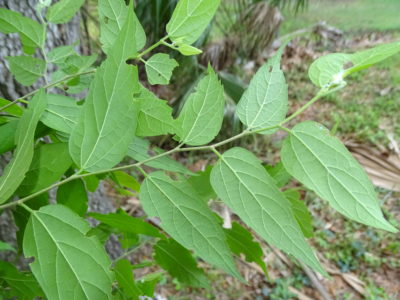By Elizabeth Gandy, Curatorial Assistant
Celtis laevigata, commonly known as hackberry or sugarberry, is an easily overlooked small to large tree found in wet to mesic hammocks throughout Florida and much of the United States (Image 1). With an affinity for calcareous or high pH soils, sugarberry can also be found on aboriginal shell mounds. The discerning plant hunter can easily learn to identify these trees. One of the first things that often draws the eye is the bark. When the trees are young, the bark is covered in longitudinal corky protrusions that superficially remind one of a winged elm. With age, the ridges break up and turn into knobby protrusions (Image 2). No other tree in the Sarasota-Manatee area has bark that is quite this furrowed or knobby.
Sugarberry leaves are pointed at the tips, smooth on the edges, sometimes a little rough on the surface, and most distinctly, asymmetrical at the base (Image 3). The leaves are deciduous, turning yellow before dropping in early winter. Flowers are small and lack petals, with separate male and female flowers found on the same tree. Three additional species of Celtis are found in Florida, the more northern common hackberry, C. occidentalis is found in drier forests, and the endangered spiny and iguana hackberries, C. pallida and C. iguanaea, respectively, are rare, but can found growing on shell mounds.
Sugarberry is one of the plants in this month’s Digging Deeper EcoQuest because of its importance to Florida’s native peoples. Our understanding of its uses comes from recent historical accounts, ethnobotanical knowledge of present day native peoples, and archaeobotanical findings from aboriginal shell mound studies.
As a member of the Cannabaceae, or hemp family, it is not surprising that the genus Celtis has been used medicinally throughout its range. The wood is useful for building as well as fuel. One of the most widely used parts is the fruit, a one-seeded drupe (think tiny peach), turning yellow to reddish at maturity (Image 4). The tasty flesh is the source of the common name of sugarberry (Celtis laevigata) as it is thought to be sweeter than the fruit of common hackberry (Celtis occidentalis). Eaten fresh, turned into jelly, or macerated and mixed with other ingredients, the fruit of the sugarberry was an important food source for native peoples. Archaeobotanical studies have found fruit and wood in undisturbed layers of archaic shell mounds in southwest Florida, providing important evidence of what resources native peoples used.
For plant hunters looking to find sugarberry for this month’s EcoQuest, some good locations include Marie Selby Botanical Gardens Historic Spanish Point campus, Oscar Scherer State Park, Circus Hammock, Terra Ceia Preserve State Park, Emerson Point Preserve, Madira Bickel Mound State Park, and Little Manatee River State Park to name a few. It is also cultivated at the Marie Selby Botanical Gardens downtown campus. Keep your eyes out for sugarberry and all the other plants in this month’s EcoQuest, Digging Deeper, wherever your plant hunting takes you!

(Image 1) View into the canopy of a sugarberry tree.

(Image 2) The distinctive warty bark of the sugarberry tree.

(Image 3) The distinctive leaf shape of the sugarberry tree.

(Image 4) The mature fruit, male flowers, and young leaves of the sugarberry tree.
